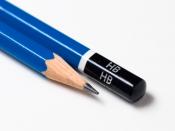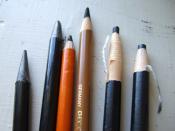Thought the interview was unnecessary, put it in as filler Thought it was all-encompassing and informative
Pencil
Silverpoint is a graphic medium which preceded the common lead pencil.
Instead of lead a point of silver wire is fixed in a wooden holder. Since
this will leave but the faintest trace on an ordinary paper surface, a
special ground must be prepared. A paste of powdered bone or chalk mixed
withwater and gum or starch is spread with a stiff brush in thin coats, each
coat being allowed to dry before another is applied to form a perfectly
smooth and even surface. The silverpoint is not so flexible a medium as
pencil, and erasure is practically impossible. The pressure of the point on
the ground demands careful control.
The main characteristics of silverpoint drawing are a fine clarity
and delicate gray tonality. In time the line turns brown through oxidation.
European artists of the 15th and 16th centuries often began their drawings
in silverpoint, finishing them with pen and ink.
Albrecht Dürer(1471-1528)
took advantage of its indelible character in using it for sketch books during
his travels. Though popular during the Renaissance, especially in the north
with the Van Eycks (active in the early 15th century) and Rogier van der
Weyden (c.1399-1464), silverpoint fell into disuse in succeeding periods. It
was revived from time to time, notably by Hendrik Goltzius (1558-1617),
Rembrandt (1606-1669), and Alphonse Legros (1837-1911). In the 20th century
it is being reinvestigated as a highly exacting but distinguished technique.
(Colliers Encyclopedia CD-ROM 1996)
The modern pencil dates from the middle of the sixteenth century,
when a new mineral that made a dark but removable mark was discovered in
England's Lake District. The new mineral was called black lead, because it
made a blacker line than metallic lead, which...


